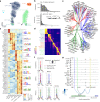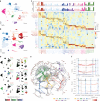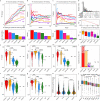SCENIC+: single-cell multiomic inference of enhancers and gene regulatory networks
- PMID: 37443338
- PMCID: PMC10482700
- DOI: 10.1038/s41592-023-01938-4
SCENIC+: single-cell multiomic inference of enhancers and gene regulatory networks
Abstract
Joint profiling of chromatin accessibility and gene expression in individual cells provides an opportunity to decipher enhancer-driven gene regulatory networks (GRNs). Here we present a method for the inference of enhancer-driven GRNs, called SCENIC+. SCENIC+ predicts genomic enhancers along with candidate upstream transcription factors (TFs) and links these enhancers to candidate target genes. To improve both recall and precision of TF identification, we curated and clustered a motif collection with more than 30,000 motifs. We benchmarked SCENIC+ on diverse datasets from different species, including human peripheral blood mononuclear cells, ENCODE cell lines, melanoma cell states and Drosophila retinal development. Next, we exploit SCENIC+ predictions to study conserved TFs, enhancers and GRNs between human and mouse cell types in the cerebral cortex. Finally, we use SCENIC+ to study the dynamics of gene regulation along differentiation trajectories and the effect of TF perturbations on cell state. SCENIC+ is available at scenicplus.readthedocs.io .
© 2023. The Author(s).
Conflict of interest statement
The authors declare no competing interests.
Figures
















Similar articles
-
Identification of genomic enhancers through spatial integration of single-cell transcriptomics and epigenomics.Mol Syst Biol. 2020 May;16(5):e9438. doi: 10.15252/msb.20209438. Mol Syst Biol. 2020. PMID: 32431014 Free PMC article.
-
GRaNIE and GRaNPA: inference and evaluation of enhancer-mediated gene regulatory networks.Mol Syst Biol. 2023 Jun 12;19(6):e11627. doi: 10.15252/msb.202311627. Epub 2023 Apr 19. Mol Syst Biol. 2023. PMID: 37073532 Free PMC article.
-
Mapping gene regulatory networks in Drosophila eye development by large-scale transcriptome perturbations and motif inference.Cell Rep. 2014 Dec 24;9(6):2290-303. doi: 10.1016/j.celrep.2014.11.038. Epub 2014 Dec 18. Cell Rep. 2014. PMID: 25533349
-
Inference of plant gene regulatory networks using data-driven methods: A practical overview.Biochim Biophys Acta Gene Regul Mech. 2020 Jun;1863(6):194447. doi: 10.1016/j.bbagrm.2019.194447. Epub 2019 Oct 31. Biochim Biophys Acta Gene Regul Mech. 2020. PMID: 31678628 Review.
-
Enhancer RNAs in cancer: regulation, mechanisms and therapeutic potential.RNA Biol. 2020 Nov;17(11):1550-1559. doi: 10.1080/15476286.2020.1712895. Epub 2020 Jan 19. RNA Biol. 2020. PMID: 31916476 Free PMC article. Review.
Cited by
-
Cell-type-specific mapping of enhancers and target genes from single-cell multimodal data.bioRxiv [Preprint]. 2024 Sep 26:2024.09.24.614814. doi: 10.1101/2024.09.24.614814. bioRxiv. 2024. Update in: Nat Commun. 2025 Apr 26;16(1):3941. doi: 10.1038/s41467-025-59306-z. PMID: 39386519 Free PMC article. Updated. Preprint.
-
Refining computational inference of gene regulatory networks: integrating knockout data within a multi-task framework.Brief Bioinform. 2024 Jul 25;25(5):bbae361. doi: 10.1093/bib/bbae361. Brief Bioinform. 2024. PMID: 39082651 Free PMC article.
-
YTHDF2 favors protumoral macrophage polarization and implies poor survival outcomes in triple negative breast cancer.iScience. 2024 May 3;27(6):109902. doi: 10.1016/j.isci.2024.109902. eCollection 2024 Jun 21. iScience. 2024. PMID: 38812540 Free PMC article.
-
Interpretable spatially aware dimension reduction of spatial transcriptomics with STAMP.Nat Methods. 2024 Nov;21(11):2072-2083. doi: 10.1038/s41592-024-02463-8. Epub 2024 Oct 15. Nat Methods. 2024. PMID: 39407016 Free PMC article.
-
Increased inflammatory signature in myeloid cells of non-small cell lung cancer patients with high clonal hematopoiesis burden.Elife. 2024 Dec 6;13:RP96951. doi: 10.7554/eLife.96951. Elife. 2024. PMID: 39641768 Free PMC article.
References
Publication types
MeSH terms
Substances
LinkOut - more resources
Full Text Sources
Molecular Biology Databases
Miscellaneous

